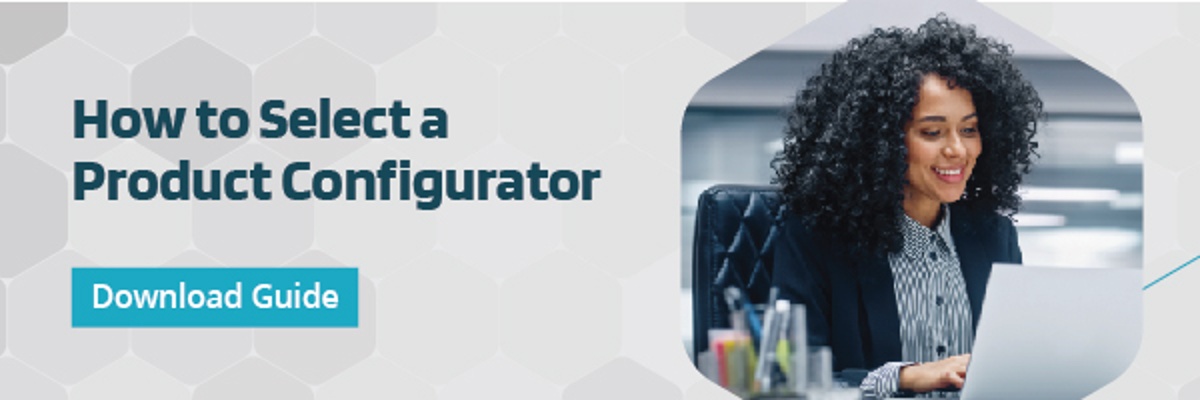This is the first blog in a series of four blogs on the topic of end-to end product configuration. At the end of this blog you will find the links to the other 3.
In the modern information society, consumers and businesses alike expect customization, even for products that were once accepted to be standardized and one-fits-all. On top of this, the information concerning the customized product, such as its price and availability, is expected to be shared immediately. Product Configurators, developed over the past decades, are a solution for this. However, to remain effective in the world of mass customization, the back-end handling of the configured product must be equally efficient to what is done on the front-end sales.
Leading companies have been pursuing a vision of seamless one-touch configuration. A vision where the only human interaction with an order is the point of sales, performed either by a salesperson or by the customer directly. This concept, also known as straight-through processing, puts advanced requirements on the systems, the data structures, and the integrations between the systems. The promise for increased speed, efficiency, and quality pushes more and more companies to investigate how they can improve further.
This is the first chapter in a series of blogs about end-to-end configuration. Here, I will share an overview, and the coming chapters will cover topics such as product assortment approaches, IT setups, and BOM structuring.
End-to-End Configuration and the Product Lifecycle
Some define end-to-end product configuration as covering the entire product lifecycle from initial product idea until service, end-of-life, and eventual replacement by a new product. In this article, we limit the definition to cover the process from detailing customer needs until all necessary information to produce and deliver a solution is ready. We are thus excluding the phases of developing a new product, the actual “product life” and end-of life. We are also excluding the pre-sales/marketing activities of detecting an initial need and converting that need to a potential customer.
If I’m a pizza maker, to make an analogy, the configuration process doesn’t start when someone is hungry. It starts when someone wants a pizza and has turned to me to see what I can do. The configuration process ends when I have defined the recipe and the delivery method for this specific customer.
.png?width=700&name=Picture1%20(3).png)
End-to-end product configuration as a sub-set of product lifecycle
Configuration, or product configuration, normally refers to the process of understanding and detailing a customer’s need and translating that into a feasible (producible) solution consisting of a combination of hardware, software, and services. The configuration process often includes aspects of optimizing the proposed solution according to lowest price, lowest cost of ownership, highest output, etc. User-friendly configurators are typically need-based, which means that they don’t rely on the user to know what parts to combine.
By adding the term end-to-end, we intentionally expand the definition of the process until all necessary information is made available to sell, produce, and deliver the solution. This necessary information can be internal as well as external. By the expansion of the process, we target the total optimization of information collection and creation in the following areas:
-
- High quality without errors or rework, a fundament for both internal efficiency and customer satisfaction
- Short lead time and limited lead time variation, a common driver for sales efficiency
- High cost and resource efficiency both in terms of sales engineering and optimal configurations
The Target of End-to-End Configuration
The target of seamless end-to-end configuration is to minimize the manual interventions and maximize the flow of correct and up-to-date information. Typical outputs of the end-to-end configuration process are:
-
- Customer quote, including specification, price, and other terms. Often, some form of visualization is also included. This is sometimes referred to as Sales Configuration or CPQ (Configure-Price-Quote).
- Other external information generated by the end-to-end configuration process can include product manuals, spare parts list, more detailed product drawings or 3D models, etc.
- One or several released production orders and purchasing orders defining what to produce, what to buy and when this should be done.
- Internal specifications, bill of materials, and different types of scheduling and plans are other internal information that can be generated in the process
.png?width=700&name=Picture2%20(3).png)
The end-to-end product configuration function must generate both internal and external information items
IT Systems Involved in End-to-End Configuration
The information systems involved in the end-to-end configuration process can include:
-
- Configurator which is the actual system or software securing that customer needs or requirements are met by an attractive solution.
- CAD (Computer Aided Design) where 3D models, electric diagrams, etc. are created and production drawings made.
- PDM/PLM (Product Data Management / Product Life-cycle Management) where engineering data as CAD models, drawings, part specifications and instructions are managed and organized into the Engineering Bill of Material (EBOM).
- ERP (Enterprise Resource Planning) where company resources such as employees, machines, inventory, stock, cash, etc are managed and where the status of main business commitments as customer orders, purchase orders, payments, etc. are controlled. The most important parts of the ERP for end-to-end configuration are MRP (Manufacturing Resource Planning) and MES (Manufacturing Execution System) where the Manufacturing Bill of Material (MBOM) is translated into production and purchasing plans (what parts or assemblies, in which quantities, according to what routing by which resources, when, etc.).
- CRM (Customer Relationship Management) where customer related information such as contacts and opportunities are linked to solutions and configurations and where quote and other offer and order related information is stored.
While many companies are already using configurators, often multiple different configurators in different areas, the seamless end-to-end configuration remains a vision that only a few companies have realized. A totally automated, seamless, end-to-end configuration is sometimes called “one-touch configuration”. “Straight-through processing” is another term used more often for financial products.
.png?width=601&name=Picture3%20(1).png)
Three Key Challenges with End-to-End Configuration
Achieving end-to-end configuration is not a simple path. Data must flow between different systems in an efficient way, meeting targets of quality, lead time, and efficiency. Three important challenges to take care of include:
Challenge 1: Complex products are often customized
Many complex products are customized and tailored for the individual customer. They are adapted to a specific process or application, to specific customer preferences, or to specific geometric constraints.
Customization and tailoring are difficult to fully design in advance. That means, even if we configure the solution based on a shared product platform, there are specific parts of the products that still need to be tailored. The tailoring typically means that CAD systems must be involved in the end-to-end information flow, adding complexity to the system setup.
Challenge 2: Integrations across multiple instances of PLM and ERP systems
Advanced companies have complex IT landscapes, often with multiple overlapping systems for the same function. Examples are multiple PLM systems across different R&D centers or different instances of ERP at different factories. Often there are historical reasons for this, such as company mergers, that leave legacies that are hard to completely remove.
This IT landscape complexity can make integrations difficult, needing consolidations and simplifications to enable a more efficient future.
Smaller companies with fewer legacies can have the opposite problem. Complete functions may be missing from the IT landscape, such as an efficient PLM system to manage the product structures and data over the life of the products.
This puts end-to-end configuration in the backlog. To automate information management, the structured and scalable solutions need to be implemented before further efficiency improvements can be implemented.
Challenge 3: Inconsistent product structures across different product families and systems
A common issue is that different product families are structured in different ways and in different product models. On top of that, the structures may also be different between systems, generating different BOMs. This makes end-to-end configuration harder since each structure would practically require a specific integration. A solution is to first restructure the product models in a more consistent way to enable simplified information management.
End-to-End Configuration for Different Types of Businesses
Depending on the nature of a product, the marketing strategy, and the internal workings of the company, solutions for end-to-end configurations will not be the same. To save effort and maintenance complexity, it is important that the system is kept as simple as possible while fulfilling the defined requirements.
.png?width=514&name=Picture4%20(1).png)
Companies from both sides of the scale are looking to get the benefits of moving towards the center. In my next blog about product configuration, I dive deeper into the topic of different product assortment operating models: Is Product Configuration for Everyone?
Product-based businesses lean towards Configuration-based to be able to do more with less – serve more customers better and deploy new functions and features faster across the range of products with less product management and engineering “administrative” work.
Project-based companies lead towards Configuration-based to enable further re-use across projects. Rather than starting each project from blank, a configurable product can serve as a base.
Two important factors in the solution design are understanding the front end (how are we presenting and selling the product) and the back end (how we generate and structure the BOM).
In both cases the back end must support the configuration approach. Otherwise, opening for configuration in the front end can lead to an explosion of complexity in the back end. The back end must ensure efficiency while allowing each order to be unique.
Analyze the Full End-to-End Configuration Process to Reveal Improvement Areas
End-to-end configuration is an important target for many businesses selling complex products. They are striving to enable faster, more efficient, and higher quality throughput from quotation to delivery. Even though it may not be efficient or even possible to fully automate the process, understanding and analyzing the whole process from end to end will reveal important areas to improve:
- How the front-end and back-end product assortment operating models are aligned to enable flexible sales while keeping internal operational efficiency.
- How product master models are structured and transformed to allow for fit-for-purpose BOMs within different functions without an unmanageable amount of Super BOMs and transformation functions.
- How IT systems are setup and integrated to support the required information flows throughout the process.
I strongly recommend downloading the guide below that will help you think through your needs, criteria, and prioritizations to direct you towards the right type of solution.
In my next blog, Is Product Configuration for Everyone? I will explore how different types of businesses can leverage product configuration and product platforms. True end-to-end configuration is perhaps not for everyone, but everyone can benefit from analyzing their situation and how they can improve. Enjoy!
Talk to us about Product Configuration!
Over the past decades, we have focused 100% on helping businesses worldwide improve their product configuration and configurability.
We are always interested to hear your story and discuss how you can improve from where you are, let us be your sounding board and reach out to me today.
Alex Ginsburg
Principal, Manager & Partner
+46 8 456 35 00
alex.ginsburg@modularmanagement.com
LinkedIn





